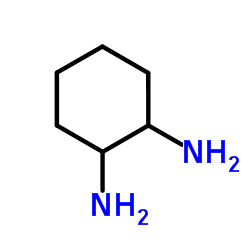1,2-Diaminocyclohexane

1,2-Diaminocyclohexane structure
|
Common Name | 1,2-Diaminocyclohexane | ||
|---|---|---|---|---|
| CAS Number | 694-83-7 | Molecular Weight | 114.189 | |
| Density | 0.9±0.1 g/cm3 | Boiling Point | 193.6±0.0 °C at 760 mmHg | |
| Molecular Formula | C6H14N2 | Melting Point | 41685ºC | |
| MSDS | Chinese USA | Flash Point | 75.0±0.0 °C | |
| Symbol |

GHS05 |
Signal Word | Danger | |
|
Mechanical stimulation of human tendon stem/progenitor cells results in upregulation of matrix proteins, integrins and MMPs, and activation of p38 and ERK1/2 kinases.
BMC Mol. Biol. 16 , 6, (2015) Tendons are dense connective tissues subjected periodically to mechanical stress upon which complex responsive mechanisms are activated. These mechanisms affect not only the development of these tissues but also their healing. Despite of the acknowledged impo... |
|
|
Steric modifications tune the regioselectivity of the alkane oxidation catalyzed by non-heme iron complexes.
Inorg. Chem. 50(24) , 12651-60, (2011) Iron complexes with the tetradentate N-donor ligand N,N'-di(phenylmethyl)-N,N'-bis(2-pyridinylmethyl)-1,2-cyclohexanediamine (bbpc) are reported. Despite the benzyl groups present on the amines, the iron compounds catalyze the oxygenation of cyclohexane to an... |
|
|
Antitumor platinum(II) complexes of N-monoalkyl-1R, 2R-diaminocyclohexane derivatives with alkyl groups as hindrance.
J. Inorg. Biochem. 112 , 68-76, (2012) A number of platinum (II) complexes, characteristic of (1R,2R)-N(1)-alkyl-1,2-diaminocyclohexane derivatives as carrier ligands, were designed, synthesized and characterized, where the alkyl group serving as hindrance is a 1-butyl, 2-methylpropyl or 2-butyl m... |
|
|
Synthesis, in vitro cytotoxicity, and interaction with DNA of platinum(II) complexes with N-monocycloalkyl derivatives of 1R,2R-diaminocyclohexane as carrier ligands.
ChemMedChem 7(4) , 642-9, (2012) A series of platinum(II) complexes with N-monocyclopentyl/cyclohexyl derivatives of 1R,2R-diaminocyclohexane as carrier ligands and dicarboxylate anions as leaving groups were synthesized and characterized. All complexes were characterized by elemental analys... |
|
|
Chiral diaminopyrrolic receptors for selective recognition of mannosides, part 1: design, synthesis, and affinities of second-generation tripodal receptors.
Chemistry 17(17) , 4814-20, (2011) A new generation of chiral tripodal receptors for recognition of carbohydrates, featuring trans-1,2-diaminocyclohexane as a key structural element, and their recognition properties toward a set of glycosides of biologically relevant monosaccharides is describ... |
|
|
Unique properties of DNA interstrand cross-links of antitumor oxaliplatin and the effect of chirality of the carrier ligand.
Chemistry 14(4) , 1330-41, (2008) The different antitumor and other biological effects of the third-generation antitumor platinum drug oxaliplatin [(1R,2R-diamminocyclohexane)oxalatoplatinum(II)] in comparison with those of conventional cisplatin [cis-diamminedichloridoplatinum(II)] are often... |
|
|
Synthesis, spectroscopic, structural characterization, electrochemical and antimicrobial activity studies of the Schiff base ligand and its transition metal complexes
Spectrochim. Acta. A. Mol. Biomol. Spectrosc. 74(3) , 617-24, (2009) In this study, the Schiff base ligand trans-N,N′-bis[(2,4-dichlorophenyl) methylidene] cyclohexane-1,2-diamine (L) and its copper(II), nickel(II) and palladium(II) transition metal complexes were prepared and characterized by the analytical and spectroscopic ... |
|
|
A mechanistic approach for the DNA binding of chiral enantiomeric L- and D-tryptophan-derived metal complexes of 1,2-DACH: cleavage and antitumor activity.
Chirality 23(3) , 250-9, (2011) A new chiral series of potential antitumor metal-based complexes 1-3(a and b) of L- and D-tryptophan have been synthesized and thoroughly characterized. Both enantiomers of 1-3 bind DNA noncovalently via phosphate interaction with slight preference of metal c... |
|
|
Origins of enantioselectivity in asymmetric ketone hydrogenation catalyzed by a RuH2(binap)(cydn) complex: insights from a computational study.
Dalton Trans. 42(6) , 2130-45, (2013) In this paper, the origins of enantioselectivity in asymmetric ketone hydrogenation catalyzed by RuH(2)(binap)(cydn) (cydn = trans-1,2-diaminocyclohexane) were discussed. Fifteen substrates involving aromatic, heteroaromatic, olefinic and dialkyl prochiral ke... |
|
|
Stereoselective UV sensing of 1,2-diaminocyclohexane isomers based on ligand displacement with a diacridylnaphthalene N,N'-dioxide scandium complex.
J. Org. Chem. 77(11) , 5203-8, (2012) Stereoselective displacement of diacridylnaphthalene N,N'-dioxide ligands, 1, from a scandium(III) complex can be used for quantitative detection of 1,2-diaminocyclohexane isomers. The diastereoselective sensing assay with Sc(syn-1)(2) shows excellent lineari... |